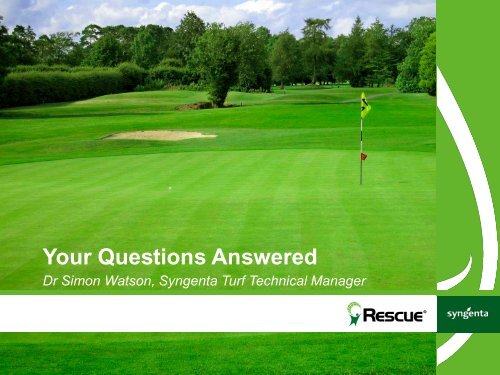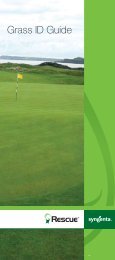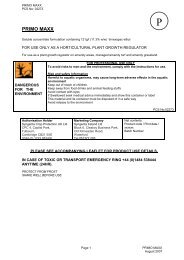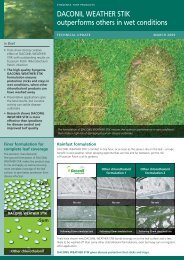Your Questions Answered - GreenCast
Your Questions Answered - GreenCast
Your Questions Answered - GreenCast
- No tags were found...
Create successful ePaper yourself
Turn your PDF publications into a flip-book with our unique Google optimized e-Paper software.
<strong>Your</strong> <strong>Questions</strong> <strong>Answered</strong>Dr Simon Watson, Syngenta Turf Technical Manager
When is the best time to start theRescue Programme?Best results in user trials have been achieved from starting with anautumn application, through September and October, when target plantsare actively growing and conditions are conducive to successful overseeding. A subsequent spring application following autumn treatmentcan provide a highly effective maintenance treatment on newly emergingRyegrass seedlings.Starting the Programme with a spring application can be effective insuppressing Ryegrass over the summer and weakening plants, whichwill be effectively killed by follow up autumn application.
Will I need to over seed followingRescue treatment?In most instances there has been a beneficial effect in over seedinggreens and fairways following Rescue treatment, to fill gaps left whentarget Ryegrass is killed-off.Over seeding helps to restore the desired population of fine turfgrasses, and prevent the ingress of unwanted grasses. This isparticularly important in the closer mown areas of the course.However, where the existing sward is actively growing, it may infillsufficiently without over seeding.
What is the best way to assuresuccess with over seeding?The recommended timing for Rescue applications in Autumn and Spring aredesigned to give seedlings emerging from over-seeding the best opportunity toestablish.After application, wait until treated plants have died back sufficiently to pass the‘Rescue Rub Test’ - the foliage on treated weed plants break up when gentlyrubbed - before over seeding. This is usually three to five weeks after application,depending on growing conditions. For best results use a specialist slot overseeding machine that will achieve good seed to soil contact, thereby improvingseed germination and seedling establishment.STRI trials have shown new seedlings can establish faster and stronger whenexisting turf has been treated with Primo Maxx five days prior to over seeding. ForSpring treatments, further applications of Primo Maxx through the season willencourage stronger rooting of seedlings and reduce the effects of stress. Ensurean adequate nutrition programme is supplied to the new seedlings.
Can I use Rescue anywhere onthe golf course?Rescue is approved for use on all turf areas around the golf course,including greens, tees, fairways and roughs.On greens, tees and fairways the primary objectives are enhancingturf playing quality and visual appearance.In rough and semi-rough areas removal of Ryegrass can help inthinning the sward to make ball location easier and speed-up play, aswell as improving the potential for environmental enhancement withnatural plant biodiversity able to thrive in more open swards.
How does Rescue selectivelycontrol certain grasses?Rescue is an ACCase inhibitor. Pinoxaden, the active ingredient inRescue, works by inhibiting the ACCase enzyme blocking thebiochemical pathway by which plants form new cell membranes. Poaannua contains a form of ACCASe that is resistant to Pinoxaden. Otherspecies, such as Ryegrass, have a form of this enzyme that is highlysusceptible.Fescue grasses have a fine leaf architecture that limits uptake of theactive ingredient and leaves plants unaffected at the recommended doserates.Grass identification is important to assess what species are present in thesward and how they will be affected by Rescue.
What about Bentgrasses?The experience of green keepers and course managers undertakingRescue User Trials has been that Colonial or Browntop Bentgrass is, forthe most part, unaffected or may exhibit some transient yellowing /browning that is quickly outgrown in good growing conditions. However,Highland Bentgrass is more susceptible and, whilst trials have shown incan also recover from the effects of Rescue, in some cases it may bekilled.What about other unwanted coarse grasses,such as Yorkshire Fog or Purple Moorgrass?Rescue is approved only for the control of Ryegrass on golf courses. Usertrials have shown that where Yorkshire Fog and Purple Moorgrass arealso present within the sward they may be controlled by Rescue at thesame time.
What would be the impact of applyingRescue to stressed turf?Rescue is a systemic herbicide that relies on the plants’ internaltransport system to distribute the active ingredient from leaf tip to root.Transport of the herbicide within stressed plants may be impaired,possibly leading to a reduced level of control of Ryegrasses.Wait for target species to be actively growing before application andmanage turf to avoid the effects of stress to maximise desired control.
What effect does Rescue have on theenvironment?Rescue has successfully passed all the latest legislative approvalprocess studies for potential environmental impact. Rescue has a fullregistration for use across all areas of golf course along with full EUAnnex 1 listing.Can play continue during the RescueProgramme?Yes. There is no need to restrict any play following Rescue Treatment. Aseries of posters and an information package have been created to helpgreenkeepers and course managers communicate with green committeesand players. The communication material details what they will see duringthe Rescue Programme, and the benefits that will be provided in betterplaying conditions in the future.
How do I integrate using Rescue intomy Primo Maxx programme?Most spring Rescue applications will take place before the Primo Maxxprogramme start. The Primo Maxx programme can commence in thespring with a pre-over seeding application (See answer on success withover seeding). Thereafter the Primo Maxx programme can continue asnormal for the remainder of the season.For autumn Rescue applications, time treatment so that the season’s finalPrimo Maxx application will be the pre-over seeding application.
What impact will fertiliser have on theactivity of Rescue?An application of fertiliser prior to Rescue application will help ensuretarget species are actively growing and not under stress. It may alsoencourage grass cover to be restored more rapidly. However, liquidfertiliser should NOT be tank mixed with Rescue.Can I make more than two applications ofRescue per year?No. The label restricts the number of applications to two per year. TheRescue Programme is designed to get the best possible results from twoapplications per season.
Can I apply Rescue at a reduced rate if I onlyhave a small amount of Ryegrass?No. Rescue should always be applied at the full permitted rate for theapplication timing, as per the label. This is a requirement for productstewardship to minimise the risk of Ryegrass developing resistance thatcould reduce the long-term efficacy of Rescue. If you only have a smallamount of Ryegrass consider spot treating areas, but always use the fullrate per hectare.Are there any restrictions with other herbicideswhen using Rescue?If a hormone herbicide (such as 2,4-D, dicamba MCPA or mecoprop-P)has been applied you must wait 21 days before applying Rescue. Afterapplying Rescue you must wait 7 day before applying a hormoneherbicide. Rescue cannot be tank mixed with any other plant protectionproducts.
How can I apply Rescue?Rescue is approved for application through boom, band and knapsacksprayers.Where can I get more advice on Rescueapplication?Sprayer set up, nozzle selection and pressure are all important tominimise drift; refer to the <strong>GreenCast</strong> Application Zone atwww.greencast.co.uk for further information and advice.











